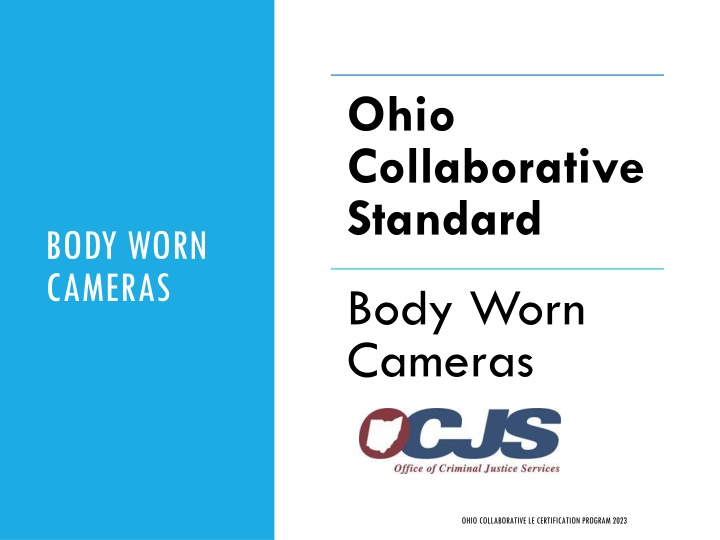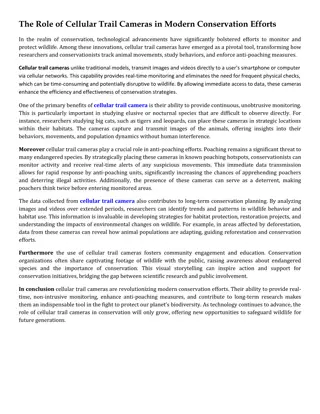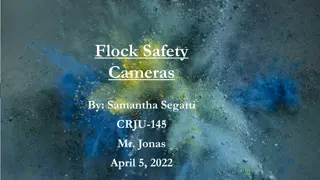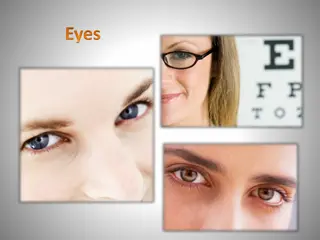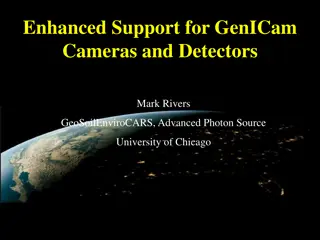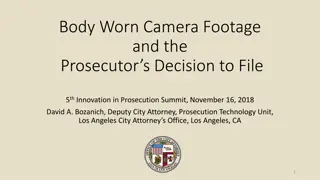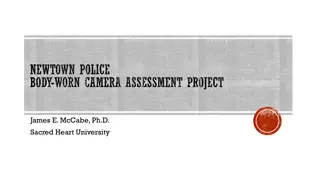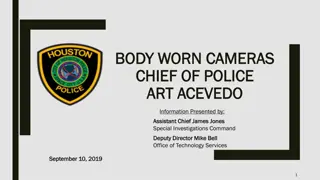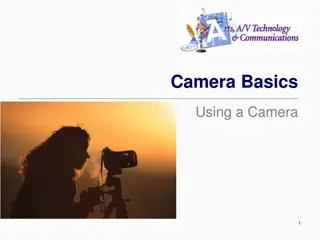Ohio Collaborative Standard for Body-Worn Cameras
The Ohio Collaborative Standard for Body-Worn Cameras outlines guidelines for law enforcement agencies regarding the use of body-worn cameras. It emphasizes the importance of clear policies, accountability, and privacy considerations. Adopted in 2016, this standard aims to enhance trust between police and the community through transparent practices.
Download Presentation

Please find below an Image/Link to download the presentation.
The content on the website is provided AS IS for your information and personal use only. It may not be sold, licensed, or shared on other websites without obtaining consent from the author.If you encounter any issues during the download, it is possible that the publisher has removed the file from their server.
You are allowed to download the files provided on this website for personal or commercial use, subject to the condition that they are used lawfully. All files are the property of their respective owners.
The content on the website is provided AS IS for your information and personal use only. It may not be sold, licensed, or shared on other websites without obtaining consent from the author.
E N D
Presentation Transcript
Ohio Collaborative Standard BODY WORN CAMERAS Body Worn Cameras OHIO COLLABORATIVE LE CERTIFICATION PROGRAM 2023
Learning Objectives Body Worn Cameras: Purpose Standard LEARNING OBJECTIVES Commentary Model policy Compliance
Police seek and preserve public favor not by catering to the public opinion but by constantly demonstrating absolute impartial service to the law. BODY WORN CAMERAS Sir Robert Peel (1829)
21st Century Policing BODY WORN CAMERAS 3.2 Recommendation: The implementation of appropriate technology by law enforcement agencies should be designed considering local needs and aligned with national standards.
In 2016, The Ohio Collaborative Community- Police Advisory Board adopted the State of Ohio Standard for Body Worn Cameras. BODY WORN CAMERAS
Purpose Law enforcement agencies and the community will benefit from clear guidelines involving the use of body-worn cameras and related privacy issues. BODY WORN CAMERAS
BODY WORN CAMERAS Standard Law enforcement agencies that use body worn cameras must establish a written policy for their use. The policy shall address the following areas:
BODY WORN CAMERAS Standard continued: Purpose and organizational philosophy regarding their use. Requirements and restrictions for activation and deactivation of the device. Criminal and administrative use of the camera captured data. Data storage, retention, and disclosure requirements reflective of public records law and privacy concerns. Accountability and training requirements for users and supervisors; and requirements for a documented review of camera captured data.
BODY WORN CAMERAS Standard Commentary Strong and consistent policies that provide guidance to personnel as to the appropriate use of the body worn cameras. Policies should address activation and deactivation, auditing, storage, retention, public records and the release of video related to victims.
BODY WORN CAMERAS Standard Commentary continued: The release of video must be carefully considered especially for child victims, injured victims, victims of sexual assault and other privacy concerns. This data is valuable as a means of accountability for law enforcement and the public. The data may not accurately reflect all that is involved in the incident, or the human and cognitive conditions of the encounter. The data shall not supersede the principles of Graham vs. Connor.
BODY WORN CAMERAS Body Worn Cameras Model Policy Purpose: To provide officers with instructions on when and how to use body-worn cameras (BWC) so that officers may reliably record their contacts with the public in accordance with the law.
BODY WORN CAMERAS Body Worn Cameras Model Policy Policy: It is the policy of the agency that officers shall activate the BWC when such use is appropriate to the proper performance of his/her official duties, where the recordings are consistent with this policy and the law. This policy does not govern the use of surreptitious recording devices used in undercover operations.
BODY WORN CAMERAS Body Worn Cameras Model Policy Administration BWC objectives Documentation of police-public incidents. Review PC for arrest, public interaction, evidentiary purposes and officer evaluation & training. Documenting crime or crash scenes.
BODY WORN CAMERAS Body Worn Cameras Model Policy Use of the BWC- situations requiring activation All contacts while performing official duties All traffic stops, OVI investigations and field sobriety tests All investigatory stops, suspicious persons or vehicle calls All jail booking of prisoners Responding to domestic disputes
BODY WORN CAMERAS Body Worn Cameras Model Policy Use of the BWC- situations requiring activation Responding to disorderly conduct or disturbing the peace calls Vehicle searches and/or inventory search Miranda warnings and responses from in custody suspects Physical or verbal confrontations or any use of force situations Any circumstance officers believe is appropriate
BODY WORN CAMERAS Body Worn Cameras Model Policy Use of the BWC Whenever possible, officers should inform individuals that they are being recorded unless unsafe, impractical, or impossible. In locations where individuals have a reasonable expectation of privacy, such as a residence, they may decline to be recorded unless the recording is being made in pursuant to an arrest or search of the residence or the individuals. The BWC shall remain activated until the event is completed in order to ensure the integrity of the recording unless the contact moves into an area restricted by this policy (see Section IV, A-F).
BODY WORN CAMERAS Body Worn Cameras Model Policy Use of the BWC If an interruption occurs, the officer will document the reason for the interruption or termination of the recording. If an officer feels it is necessary to stop recording (e.g. talking to a victim of sexual assault, confidential informant) within the constraints of policy, the officer will verbally indicate their intent to stop recording before stopping the device, and upon reactivation, state that the camera has restarted. Documentation can be in the form of an incident report or other means approved by the agency CEO.
BODY WORN CAMERAS Body Worn Cameras Model Policy Use of the BWC If an officer fails to activate the BWC, the officer will document why a recording was not made. Documentation can be in the form of an incident report or other means approved by the agency CEO. Civilians shall not be allowed to review the recordings at the scene. Personal use of BWC equipment on or off duty is prohibited.
BODY WORN CAMERAS Body Worn Cameras Model Policy Procedures for use of the BWC BWC equipment is issued primarily to on-duty personnel as authorized by the agency. Officers who are assigned BWC equipment must use the equipment unless otherwise authorized by supervisory personnel. Officers shall use only BWCs issued by the agency. The BWC equipment and all data, images, video, and metadata captured, recorded, or otherwise produced by the equipment is the sole property of the agency.
BODY WORN CAMERAS Body Worn Cameras Model Policy Procedures for use of the BWC BWC issued equipment is the responsibility of the officer and proper care to ensure functioning. Equipment malfunctions should be reported as soon as possible. Officer should inspect and test the equipment prior to each shift and notify a supervisor if malfunctioning. Officers shall not edit, alter, erase, copy, share or otherwise distribute in any manner BWC recordings without prior authorization from the agency CEO. Officers are encouraged to report to a supervisor any recording which may be useful for training purposes.
BODY WORN CAMERAS Body Worn Cameras Model Policy Procedures for use of the BWC Requests for deletion of the recordings (in the event of a personal recording) must be submitted in writing and approved by the agency CEO or designee in accordance with Ohio record retention laws. All requests and final decisions shall be kept on file. When preparing written reports, officers should review their recordings as a resource. The report notation should contain the BWC unit s identification (i.e. BWC-XX). BWC recordings are not a replacement for in-car video or written reports.
BODY WORN CAMERAS Body Worn Cameras Model Policy Restrictions on using the body-worn camera BWCs will be used only for official duties. BWCs will not be used for: Communication with agency personnel without the approval of the agency CEO. Encounters with undercover officers or confidential informants. When on break and in areas where there is a reasonable expectation of privacy such as restrooms and locker rooms.
BODY WORN CAMERAS Body Worn Cameras Model Policy Restrictions on using the body-worn camera BWCs will be used only for official duties. BWCs will not be used for: Any purpose that is contrary or inconsistent with the agency s mission and core values or in any way that is contrary to federal, state and local law. While in patient care areas of a healthcare facility, unless the patient becomes adversarial with the officer. The officer shall record for law enforcement purposes only, but not record any patient/ doctor conversations; having discussions with attorneys, peer support counselors, doctors, etc.
BODY WORN CAMERAS Body Worn Cameras Model Policy Storage All BWC files shall be securely downloaded periodically and no later than the end of each shift. Each file shall contain information related to the date, BWC identified and assigned officer. The procedures for downloading files from the BWC to the server shall be in accordance with manufacturer and agency agreements on file. All images and sounds recorded are agency property. Accessing, copying or releasing files for non-law enforcement purposes is strictly prohibited. All access to BWC files must be specifically authorized by the agency CEO or designee, and all access is to be audited to ensure authorized uses for legitimate purposes. Files should be securely stored in accordance with State records retention laws and no longer than useful for purposes of training or for use in an investigation or prosecution.
BODY WORN CAMERAS Body Worn Cameras Model Policy Supervisor Responsibilities: Responsible and have discretion for the assignment of the BWCs based on the availability of the equipment and agency needs. Ensure personnel are using the BWC in accordance with policy and procedure.
BODY WORN CAMERAS Body Worn Cameras Model Policy Supervisor Responsibilities: On a monthly basis, supervisors will conduct documented random reviews of BWC recordings of traffic stops and citizen contacts. Also, reviewing reports generated as a result of these incidents and activities to ensure that the equipment is operating properly, the use is in compliance and identify any areas in which additional training or guidance is required. The agency CEO or designee will review BWC captured data and conduct a documented annual review of the data, frequency and use.
BODY WORN CAMERAS Body Worn Cameras Model Policy Release of Body Worn Camera Recordings Any request for the release of Body Worn Camera recordings will be directed to the agency CEO or designee. The release of recordings will be consistent with Ohio Public Records laws (149.43).
BODY WORN CAMERAS Body Worn Cameras Model Policy Training All body worn camera operators and supervisors will complete an annual review of this directive and complete knowledge testing on the proper use of the equipment. Testing may include the following topics: All practices and protocols of this policy; An overview of relevant state and federal laws governing consent, evidence, privacy, and public disclosure; Procedures for operating the equipment safely and effectively; Scenario-based exercises that replicate situations officers might encounter in the field; Procedures for downloading and tagging recorded data; Procedures for accessing and reviewing recorded data (restricted to personnel authorized to access the data); Procedures for preparing and presenting digital evidence for court, and Procedures for documenting and reporting any malfunctioning device or supporting systems.
BODY WORN CAMERAS Body Worn Cameras Standard Annual Compliance Proofs: Report demonstrating activation/de-activation of body camera (bullet B) Retention log, public records requests, evidence log, etc. (bullet C & D) Supervisor review log (bullet E) Read/Sign (bullet F)
